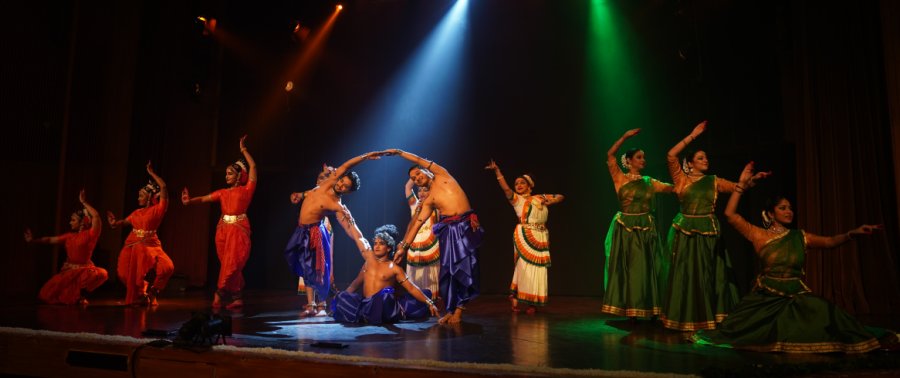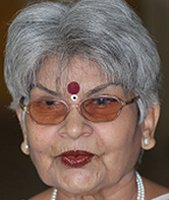
|   |

|   |
Jai Bharat: An ode to the nation - Manjari Sinha e-mail: manjari@sinha.com November 24, 2022 The Kuchipudi Dance Academy and Guru Jayarama Rao presented 'Jai Bharat', an adoration of our motherland, a vibrant tapestry of dance woven with distinct threads of multihued Indian dance forms like Chhau, Kuchipudi. Mohiniyattam and Kathak, at the India Habitat Centre (Delhi) recently. Supported by the Ministry of Culture, Govt of India, and conceived by Guru Jayarama Rao, this innovative choreography involved choreographers like gurus Bharati Shivaji (Mohiniyattam), Geetanjali Lal (Kathak), Kuleshwar Kumar Thakur (Chhau) and Jayarama Rao himself with Kuchipudi choreography, paying homage through their dance forms that have an unbroken tradition of centuries of Indian culture. In celebration of India's 75 years of independence, the gurus, choreographers, musicians and performing artistes interpreted 'Azadi ka Amrit Mahotsav' through their respective art forms exploring the Indian identity that continues to thrive in the face of adversity. The twenty-four dancers and sixteen musicians in four dance forms proved with their powerful collaboration that artistic expression truly has no boundaries. Together they heralded their motherland through the Sanskrit lyrics "Bharatho mama deshoyam Bharatheeyaashcha baandhavaaha, paraanuraktirasmin me deshesti mama sarvadaa" meaning, 'Bharat (India) is my country and all Indians are my friend and relatives. My interest always lies in the well-being of my country.'  The evening opened with 'Pancha Mahabhoot', an ode to the five elements that constitute the whole universe. The intriguing formation of four Chhau dancers making a circle in Shirshaasana led by Kuleshwar standing in the middle, as if emerging from the austere and tuneful drone of taanpura to invoke the five elements namely Earth, Water, Fire, Air, and Space, which are the basis of all cosmic creation. These elements have different characteristics like Shabda (sound), Sparsha (touch), Roop (sight), Rasa (taste), and Gandha (smell), which account for different faculties of human experience, also called Gunas. The Indian identity in this universal context underlines our belief in collectivity. In 'Pancha Bhoot' the earth was shown with its flora and fauna, the flowers, butterfly, and the dancing peacock. The water came next with the showers of rain, the flowing river and its pleasing splashes. The fire had scenes of yajna with the havan-kund surrounded by four dancers performing the sacrificial fire rituals. The other scene had four dancers carrying a dead body to the cremation ground and burning a pyre. The space showed the Akash and the air blowing like a sweet breeze and gradually turning into the powerful outrage of a storm. The thoughtfully conceived choreography performed in the Chhau style led by Kuleshwar Thakur had the most imaginatively composed music to enhance it. This invocatory piece also worked as the 'Purva-Rang' or preface for 'Jai Bharat', the veneration of the 'Sujala, Suphala, Shasya Shyamala' motherland which is created with all these elements and their respective gunas. The scene changed with the melodious swaras of raga Desh in which the Desh Vandana "Bharato maam deshoyam..." was composed. Different stanzas of the patriotic poem were interpreted by four different dance styles, but the lead was taken by the well trained Kuchipudi dancers of the Kuchipudi Dance Academy. The group choreography by Guru Jayarama Rao had perfect synchronization in various formations of Kuchipudi, Mohiniyattam, and Kathak. The Mohiniyattam disciples of Bharati Shivaji presented 'Mukhachalam' followed by 'Pandattam', the joyous game of ball played with agility based on the well-known composition of Vallathol Narayana Menon in raag Nilambari. The two separate compositions intertwined together showed both the distinguishing grace of Mohiniyattam and its ability to bring alive reflections of our lived experiences. The Kuchipudi solo "Jayamu jayamu....", originally a prayer to Saraswathi, the goddess of learning, also paid obeisance to Siddhendra Yogi, creator of Kuchipudi dance style and founder of the Kuchipudi village, and other teachers and thinkers. It was the choreography of Guru Vempati Chinna Satyam. The Kathak dancers added a Thumri abhinaya to this multi-hued fare. Choreographed by Guru Geetanjali Lal, the Thumri "Kaise ho mose karat chhed..." depicts the 'Chhed-Chhad' of Gopis and Radha with Krishna. It was a traditional Thumri composed in raag Bageshri set to Addha Theka of teentaal. The Tode-Tukde, Parans, and Chakkardaar Tihai were beautifully interspersed in-between the sthayee and antara along with the Gat-Nikas and Gat-Bhaav, elucidating the shringar rasa.  The concluding group choreography of 'Jai Bharat' combined dancers from all four dance styles coming gradually on stage, dancing to a scintillating Thillana. This also had a thrilling sequence of 'sawal-jawab' building up the crescendo for the concluding salutation to Mother India. The climaxing idolization of the motherland as the Trimurti of goddesses Durga, Lakshmi and Saraswathi, was soaked in devotional fervour with the Sanskrit shloka "Tvam hi Durga Dashaprahar Dharini, Kamala Kamaldal Viharini, Vani Vidya dayini...." composed by Bankim Chandra Chattopadhyay, concluding with "Sujalam Suphalam Mataram, Vande Mataram!" in a beautiful collage like freeze that got them a standing ovation.  Manjari Sinha has an M.A. in Sanskrit and Music, and trained in vocal, tabla, sitar and Kathak dance. She has regular columns in national dailies as a music and dance critic. |